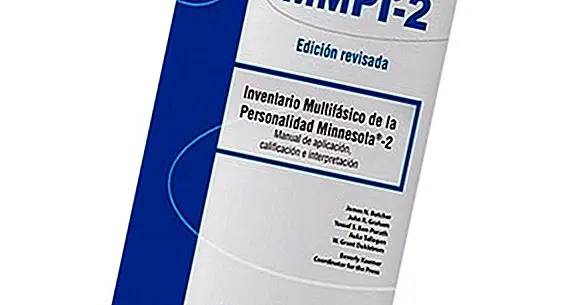Minnesota Multiphasic Personality Inventory (MMPI-2): how is it?
The human personality is one of the most difficult psychological constructs to describe . Some theories define it as those stable and distinctive characteristics of a person that are manifested through behavior.
Despite the complexity of its definition, there are some evaluation tests that allow a psychological profile of the personality to be adjusted to the reality of the subject. One of the most used is the MMPI-2 , whose operation we will review throughout this article.
- Related article: "The 4 types of personality tests"
What is MMPI-2?
The Minnesota Multiphasic Personality Inventory , in this specific case, the MMPI-2 is one of the most popular instruments within psychology to assess personality, the psychopathological characteristics of a person and the psychosomatic alterations.
This last version developed in 1989 from the original MMPI enjoys great popularity because it allows the mental health professional to establish valid or reliable opinions or judgments about the patient's personality. In the same way, enables the creation of a very complete psychological profile .
This inventory of personality constructs is made up of 567 dichotomous option items in which the person must choose between true or false according to whether he identifies with the affirmation or not.
The MMPI-2 gives us the opportunity to evaluate the basic characteristics of the personality through a series of scales , categorized as basic or additional. The basic scale consists of 370 items that are divided into validity scales and clinical scales. While the additional ones allow to expand the information of the basic scales, discriminating the content and nature of the symptoms.
Finally, this test is considered as a basic evaluation tool, so it can be applied in all those areas where an evaluation of personality traits is needed. Among these administrative contexts are: research centers and psychological clinics, teaching centers or military or defense contexts.
Characteristics of this psychological test
The MMPI-2 has a series of distinctive features that make it the test most used when developing a psychological personality profile . These characteristics are given at the level of administration, as well as objectives and reliability.
1. Objective
As indicated at the beginning of the article, the objective of MMPI-2 is to develop a psychological profile of the personality traits of the person evaluated. As well as identifying possible psychopathological characteristics, or anomalous personality traits .
2. Material
This test can be done both virtually and in a classical way (pencil and paper). She will need the MMPI-2 question protocol and the grid with the answer grid. In addition, the correction key is required for the evaluation.
3. Administration
The standard instructions for the administration of this are contained in the MMPI-2 test package. The estimated time for the application of the test varies between 90 and 120 minutes , and should always be performed in the presence of a psychologist or mental health professional. To be able to be, accompanied by an observer also professional.
Due to the complexity of the test it is necessary that the evaluator has read the material before using it. Then, the necessary material will be given to the person evaluated and the test will be explained. Throughout this, the evaluator can answer the doubts that arise to the evaluated one, since the MMPI-2 presents greater validity if it responds to all the items.
4. Score
After completing the test, you will go to the correction stage, in which the evaluator will grant one point for each affirmative or true response from the patient and 0 points in the boxes marked as false . In the end, all the points are added to obtain the gross score of the scale as a result of which the T score will be obtained that will allow us to interpret the results of the test.
Your scales
As mentioned previously, the MMPI-2 consists of 567 items arranged in different evaluation scales . These scales are divided into the basic scales, composed of validity scales and clinical scales, and additional scales.
1. Clinical scales
The objective of these scales is to investigate a possible presence of psychopathological symptoms. Within this scale are the following personality factors:
- Hypochondria.
- Depression.
- Hysteria.
- Psychopathic deviation.
- Paranoia .
- Psychasthenia.
- Schizophrenia.
- Hypomania .
- Social introversion.
- Masculinity-Femininity (divided into women and men).
2. Validity scales
The validity scale allows us to detect if there is intentionality to lie or incoherence in the responses of the evaluated. This scale includes:
- Scale L or lie .
- Scale F or inconsistency or validity.
- K scale or correction or defense.
3. Additional scale
As a complement to the basic scales, and with the intention of expanding the information provided by these, the evaluator can use the additional scales that measure constructs such as:
- Anxiety.
- Fear
- Obsessiveness .
- Depression.
- Concern for health.
- Extravagant thought.
- Hostility.
- Cynicism.
- Antisocial behavior .
- Type A behavior
- Low self-esteem.
- Social discomfort
- Labor problems
- Labor interference
- Negative treatment indicators that show whether the patient needs hospitalization or not.
How are the scores interpreted?
According to the T score obtained by the patient, the scales can be interpreted based on the following classification:
- Score T <40: As a general rule, scores can not be obtained for less than 40, so it will be necessary to examine the L-scale score to find out if the person intends to give a good image of herself .
- T = 40-50: Corresponds to a very low score so it has no diagnostic significance. An analysis of the L scale should also be performed.
- T = 41-55: They belong to the expected score in the population, so it also has no diagnostic significance.
- T = 56-65: Moderate diagnostic significance. Some of the scales should be reviewed to investigate which personality traits stand out .
- T = 66-75: High diagnostic significance. From this score, pathological personality traits may appear.
- T> 75: Extremely high diagnostic significance. Only occurs in 10% of cases, so you should consider the possibility that the person is exaggerating or that means a request for urgent help.



















